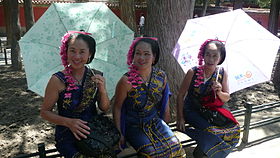- Tai peoples
-
- "Thai peoples" redirects here. For the subgroup of the Tai, see Thai people
Tai Tai women in Yunnan. Regions with significant populations China (Dai), Myanmar/Burma (Shan), Laos, Thailand, Vietnam and India (Ahom) Languages Tai–Kadai languages, languages of resident countries
Religion Theravada Buddhism, animism
Tai peoples are a subgroups of Tai speakers, roughly covers the Southwestern Tai speakers. Tai speakers not included in Tai peoples are called Rauz peoples. In China, Tai peoples (excluding Rauz peoples) are under a cluster called Dai people and in Burma they're known as Shan people.
Contents
Origin of the Tai
See also: Peopling of Thailand and Peopling of LaosLinguist Laurent Sagart recently[when?] hypothesized that the proto-Tai–Kadai language originated as an Austronesian languages that migrants carried from Taiwan to mainland China. Afterwards, the language was then heavily influenced by local languages from Sino-Tibetan, Hmong–Mien, or other families, borrowing much vocabulary and converging typologically.[1][2] Much closer to the present, some peoples speaking Tai languages migrated southward over the mountains into Southeast Asia, perhaps prompted by the coming of the Han Chinese to south China.
Linguistic heritage is not synonymous with genetic heritage, because of language shift where populations learn new languages. Tai people tend to have very high frequencies of Y-DNA haplogroup O2a with moderate frequencies of Y-DNA haplogroups O2a1 and O1. However, it is believed that the O1 Y-DNA haplogroup is associated with both the Austronesian people and the Tai. The prevalence of Y-DNA haplogroup O1 among Austronesian and Tai peoples also suggests a common ancestry with the Sino-Tibetan, Austro-Asiatic, and Hmong–Mien peoples some 35,000 years ago in China.[3] Y-DNA haplogroup O2a is found at high frequency among most Tai peoples, which is a trait that they share with the neighboring ethnic Austro-Asiatic peoples of Yunnan in southern china. Y-DNA haplogroups O1 and O2a are subclades of O Y-DNA haplogroup, which itself is a subclade of Y-DNA haplogroup K, a genetic mutation that is believed to have originated 40,000 years ago, somewhere between Iran and Central China.[4]
Tai groups and names
Chinese Pinyin Tai Lü Tai Nüa Thai Conventional Area(s) 傣仂
(西雙版納傣族自治州)Dǎilè
(Xīshuāngbǎnnà Dǎi)tai˥˩ lɯː˩ ไทลื้อ Tai Lü, Tai Lue Sipsongpanna Tai Autonomous Prefecture (China) 傣那
(德宏傣)Dǎinà
(Déhóng Dǎi)tai˥˩ nəː˥ tai
le6ไทเหนือ, ไทใต้คง Tai Nüa, Northern Tai, Upper Tai, Chinese Shan Dehong (China); Burma 傣擔 Dǎidān tai˥˩ dam˥ ไทดำ, ลาวโซ่ง, ผู้ไท Tai Dam, Black Tai, Tai Lam, Lao Song Dam*, Tai Muan, Tai Tan, Black Do, Jinping Dai, Tai Den, Tai Do, Tai Noir, Thai Den Jinping (金平) (China), Laos, Thailand 傣繃 Dǎibēng tai˥˩pɔːŋ˥ ไทเบง Tay Pong Ruili (瑞丽), Gengma (耿马) (China),
along the Mekong傣端 Dǎiduān tai˥˩doːn˥ ไทขาว White Tai, Tày Dón, Tai Khao, Tai Kao, Tai Don, Dai Kao, White Dai, Red Tai, Tai Blanc, Tai Kaw, Tày Lai, Thai Trang Jinping (金平) (China) 傣雅 Dǎiyǎ tai˥˩jaː˧˥ ไทหย่า Tai Ya, Tai Cung, Cung, Ya Xinping (新平), Yuanjiang (元江) (China) 傣友 Dǎiyǒu tai˥˩jiu˩ ไทยโยว Yuanyang (元阳) (China),
along the Red River* lit. "Lao [wearing] black trousers" Other Tai populations
Throughout Asia
There is a large Shan community within Sri Lanka which settled in Sri Lanka from mainland India.[citation needed] In other parts of Asia, substantial Thai communities can be found in Japan, Taiwan and the United Arab Emirates.
Tai of North America
The United States is home to a significant population of Thai, Lao, Tai Kao, Isan, Lu, Phutai, Tai Dam, Tay and Shan people. There are a significant number of Thai and Lao people living in Canada as well.
See also: Thai American and Laotian AmericanTai of Europe
The most significant communities of Tai peoples in Europe are in the Lao communities of the United Kingdom, France, Germany and Switzerland, the Isan communities of the United Kingdom and Iceland, the Thai communities of Finland, Iceland and Norway, the Tai Dam and Tay communities of France, and the Southern Thai community of the United Kingdom.
Thai of Oceania
There is a sizable Thai community in Australia, as well as a Northeastern Thai community in New Zealand.
Lao of Argentina
In recent times, large numbers of Lao have migrated to Argentina.
References
- ^ http://hal.archives-ouvertes.fr/docs/00/09/09/06/PDF/THE_HIGHER_PHYLOGENY_OF_AUSTRONESIAN.pdf Sagart, L. 2004. The higher phylogeny of Austronesian and the position of Tai–Kadai. Oceanic Linguistics 43.411-440.
- ^ Stratification in the peopling of China: how far does the linguistic evidence match genetics and archaeology?
- ^ Y-DNA Haplogroup O and its Subclades – 2007
- ^ Y-DNA Human Migration
Categories:- Ethnic groups in China
Wikimedia Foundation. 2010.

